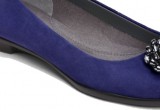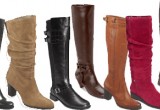The Inside Scoop: Top 10 Reasons Women Can't Find Shoes That Fit
Over 60% of women in the USA can not find their correct shoe size in regular shoe stores. Less than 5% of the shoe companies in the US even make shoes for this 60%+ of USA women. Why? Here are the Top 10 Reasons for this "market disconnect".
Online, August 20, 2013 (Newswire.com) - The Shoe Lady- a Harvard Business School graduate with over 15 years in the footwear industry- has just returned from a major shoe show in New York City. These shows exhibit footwear styles for upcoming seasons and are all about choices and options. Yet as she wandered the streets of Manhattan she was reminded how difficult it is for women to find shoe styles that fit. Somehow in the age of individual medicine, individual media and made to order cars, it is still hard to find modern and fashionable styles that really fit our larger and wider feet. Here, The Shoe Lady pulls back the curtain on the shoe industry to reveal the insider scoop on why so many women can't find shoes that fit.
1. Customers do not understand the width system in shoe sizing, or even that widths other than medium are available. So they do not ask for what they don't see. This is where the problem begins. A woman who needs a 7 Extra Wide will buy a 10 Medium. Really.
2. Shoe companies complain about the cost of producing additional "lasts" (the frame a shoe is built on) for additional sizes and widths, beyond the basic whole sizes from 5 to 10. So they save money by making fewer lasts. Six different sized lasts for 8,000 pairs compared to 85 different lasts for an 8,000 pairs saves a lot of money.
3. Factories that shoe companies hire to make the shoes would prefer to make more shoes in fewer sizes and widths because changing a size and width requires additional time. This is distracting for the factory worker, offers opportunities for error, and increases the production price.
4. Shoe companies are reluctant to push factories to make styles in extra sizes and widths because they don't want to strain the relationship with good factories.
5. Shoe companies believe the more sizes and widths (or "categories") that a shoe style is separated into, the more likely there will be unsold inventory at the end of season. Some of these categories may not sell out, leaving the shoe company with leftover shoes in odd sizes.
6. Shoe companies plan based on prior year sales for what they will order in each size/width category based on what they sold the prior year in that size/width category. And they've been looking backward for years.
7. Shoe companies do not factor in the substantial change in women's average shoe size, from size 7 in 1990 to size 9 in 2013. Since they don't track real size trends in the population, shoe companies rely on what they think the sales might be based on prior year selling history. They don't look at the "bell curve" of women and shoe size.
8. Shoe companies do not track the sales lost because the sizes were not available. Shoe company reports are based on sales per style, per color, per heel height, re-orders and other data related to the shoe style and the retailer. But they do not track the number of shoes sold per size/width category, the change over time in that category, and the estimate of the sales they lost because sizes and widths were not available.
9. "Brick and mortar" shoe store pre-season orders skew production plans for shoes. Due to space and financial constraints, brick and mortar stores have rarely been interested in carrying a wide variety of sizes and widths. Their sales are primarily based on visual cues to attract the customer, such as the styles shown in the window and on the salon shelves. Six sizes and only one width suits this business model perfectly. It is up to the customer to squeeze into the shoe or go without. So companies are not inclined to argue with factories for sizes and widths that their core brick and mortar retailers don't want.
10. Customers don't demand shoes that fit properly in styles that meet their needs. Many customers feel that what they see (made available based on the reasons above) is what they can get. The internet, including e-commerce sites like DesignerShoes.com that offers fine fashion shoes for women who leave a larger footprint, provide a greater selection of footwear. However, unless there is an active demand by customers for proper fitting styles, shoe companies won't be willing to overcome inertia and make styles that fit women who are not "perfectly average." Over 60% of all women can't find their correct size in regular shoe stores.
AskTheShoeLady.com is a blog answering readers' questions about shoe fit and fashion. It is associated with DesignerShoes.com. DesignerShoes.com offers women's shoe sizes from 4 to 16 and focuses on serving the plus size and hard to find size women's shoe market.
Barbara Thornton Founder and President of DesignerShoes.com.
About Us: http://www.designershoes.com/about-us/




